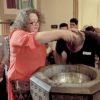Third Places are the new multi-purpose building.

At one point in the church growth era, there was a trend in constructing multipurpose buildings. For the most part these could be used for a variety of purposes—an auditorium, gymnasium, or fellowship hall.
Later, the space was used in attempts to reach the community during the week. While this is still common, another building project is growing in popularity—the “third place.”
In this two-part article I want to introduce you to the concept of third place, provide a brief list of the benefits of third places, and offer some examples of churches that have created third places.
Concept of a Third Place
Ray Oldenburg, retired sociology professor of the University of South Florida, coined the term “third place.” In his book The Great Good Place, Oldenburg describes third places as: “A generic designation for a great variety of public places that host the regular, voluntary, informal, and happily anticipated gathering of individuals beyond the realms of home and work.”
He emphasized that third places are gathering places that can be described as “homes away from home”:
All great cultures have had a vital public life and, necessarily, they evolved their own popular versions of those places that played host to it. … Thus, its profusion of sidewalk cafes seems to be Paris, just as the forum dominates one’s mental picture of classic Rome. The soul of London resides in her many pubs; that of Florence in its teeming piazzas. Vienna’s presence is seen and felt most within those eternal coffeehouses encircled within her Ringstrasse. … In cities blessed with their own characteristic form of these Great Good Places, the stranger feels at home—nay, is …


